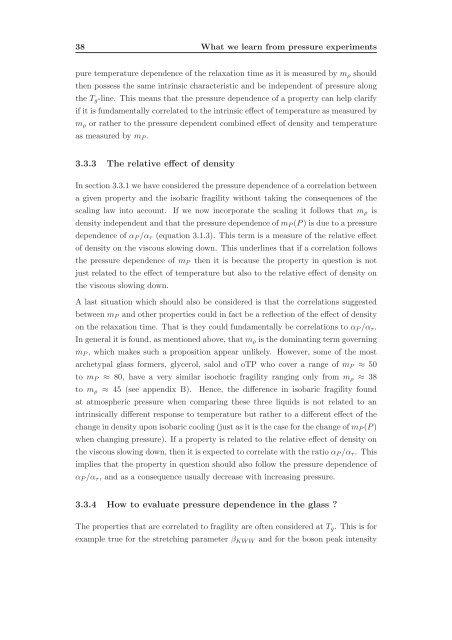Ph.D. thesis (pdf) - dirac
Ph.D. thesis (pdf) - dirac
Ph.D. thesis (pdf) - dirac
You also want an ePaper? Increase the reach of your titles
YUMPU automatically turns print PDFs into web optimized ePapers that Google loves.
38 What we learn from pressure experiments<br />
pure temperature dependence of the relaxation time as it is measured by m ρ should<br />
then possess the same intrinsic characteristic and be independent of pressure along<br />
the T g -line. This means that the pressure dependence of a property can help clarify<br />
if it is fundamentally correlated to the intrinsic effect of temperature as measured by<br />
m ρ or rather to the pressure dependent combined effect of density and temperature<br />
as measured by m P .<br />
3.3.3 The relative effect of density<br />
In section 3.3.1 we have considered the pressure dependence of a correlation between<br />
a given property and the isobaric fragility without taking the consequences of the<br />
scaling law into account. If we now incorporate the scaling it follows that m ρ is<br />
density independent and that the pressure dependence of m P (P) is due to a pressure<br />
dependence of α P /α τ (equation 3.1.3). This term is a measure of the relative effect<br />
of density on the viscous slowing down. This underlines that if a correlation follows<br />
the pressure dependence of m P then it is because the property in question is not<br />
just related to the effect of temperature but also to the relative effect of density on<br />
the viscous slowing down.<br />
A last situation which should also be considered is that the correlations suggested<br />
between m P and other properties could in fact be a reflection of the effect of density<br />
on the relaxation time. That is they could fundamentally be correlations to α P /α τ .<br />
In general it is found, as mentioned above, that m ρ is the dominating term governing<br />
m P , which makes such a proposition appear unlikely. However, some of the most<br />
archetypal glass formers, glycerol, salol and oTP who cover a range of m P ≈ 50<br />
to m P ≈ 80, have a very similar isochoric fragility ranging only from m ρ ≈ 38<br />
to m ρ ≈ 45 (see appendix B). Hence, the difference in isobaric fragility found<br />
at atmospheric pressure when comparing these three liquids is not related to an<br />
intrinsically different response to temperature but rather to a different effect of the<br />
change in density upon isobaric cooling (just as it is the case for the change of m P (P)<br />
when changing pressure). If a property is related to the relative effect of density on<br />
the viscous slowing down, then it is expected to correlate with the ratio α P /α τ . This<br />
implies that the property in question should also follow the pressure dependence of<br />
α P /α τ , and as a consequence usually decrease with increasing pressure.<br />
3.3.4 How to evaluate pressure dependence in the glass ?<br />
The properties that are correlated to fragility are often considered at T g . This is for<br />
example true for the stretching parameter β KWW and for the boson peak intensity

















